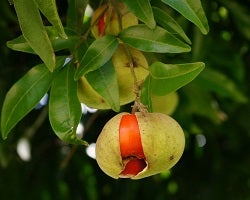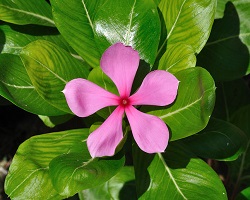Powerful Plants

Of all the Earth’s land biomes, rainforests change the most amount of energy coming from the sunlight into food (like sugars). We call this action photosynthesis.
After plants change sunlight energy into sugars, animals can get that energy by eating the leaves, fruits, or other parts of the plants. This can be good or bad for the plants, so over many, many years, plants have come up with ways to trick animals into eating certain plant parts while avoiding others.

A Sweet Trick
Plants pack their fruits with sugar, making them a sweet and tempting treat for many animals. This is because fruits also hold the seeds of a plant.
By hiding their seeds in delicious fruits, plants are tricking animals into eating them. That way, the animals spread (disperse) the seeds inside the fruits to other areas of the rainforest.
Directing Water
When you compare the plants of the rainforest to those in other biomes you begin to see one big difference, the leaves. Most of the plants have large leaves and some you could say are huge. They also have a particular shape. They come to a point that is called a drip tip. This shape helps to direct the water to specific locations.
The Fight for Life

But what about the parts of a plant that need to be protected and not eaten? To fight off animals like insects that try to eat their leaves and shoots, some plants make certain chemicals called toxins. These toxins taste bad or make animals sick, so animals will not eat those parts of the plant.
Plant Medicine
What is toxic to some can be helpful to others—humans have been able to use some of the chemicals found in tropical plants as medicines. This is just one of the many reasons why we should preserve the biodiversity, or diversity of life, that the rainforests hold.
Leaf Mystery
When you explore a biome it is important to take a moment to observe even the smallest of details. For example, the leaf in the video below has a pattern of regular holes in the leaf. What could cause this? Are insects making holes in a pattern? Think about it for a little bit and come up with your answer before you play the video.
Images via Wikimedia. Rafflesia image by Henrik Ishihara.
Read more about: Revealing the Rainforest
Bibliographic details:
- Article: Plants of the Rainforest
- Author(s): Dr. Biology
- Publisher: Arizona State University School of Life Sciences Ask A Biologist
- Site name: ASU - Ask A Biologist
- Date published:
- Date accessed:
- Link: https://askabiologist.asu.edu/plants-rainforest
APA Style
Dr. Biology. (). Plants of the Rainforest. ASU - Ask A Biologist. Retrieved from https://askabiologist.asu.edu/plants-rainforest
Chicago Manual of Style
Dr. Biology. "Plants of the Rainforest". ASU - Ask A Biologist. . https://askabiologist.asu.edu/plants-rainforest
Dr. Biology. "Plants of the Rainforest". ASU - Ask A Biologist. . ASU - Ask A Biologist, Web. https://askabiologist.asu.edu/plants-rainforest
MLA 2017 Style

The rainforest has some very unusual plants, like this Rafflesia. This plant parasite doesn't have roots of its own, but grows tissue in other plants to steal the nutrients it needs.
Be Part of
Ask A Biologist
By volunteering, or simply sending us feedback on the site. Scientists, teachers, writers, illustrators, and translators are all important to the program. If you are interested in helping with the website we have a Volunteers page to get the process started.

